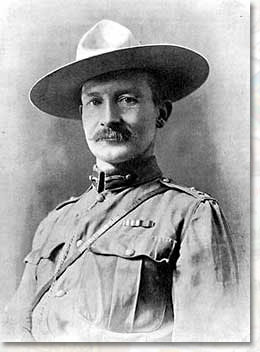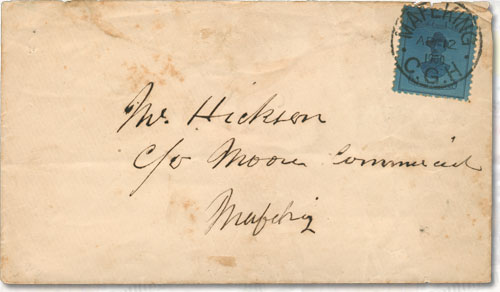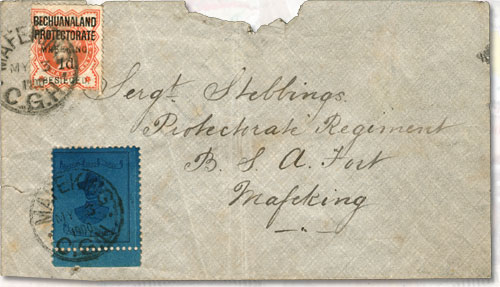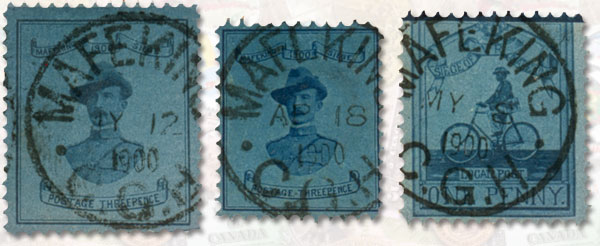 | ||||
|
|
||||
|
Mafeking Siege Stamps and the beginning of the Boy Scouts Movement |
Warner Goodyear was a 12 year old boy caught up in the 8-month siege of Mafeking. He is immortalized on the first of three rare postage stamps produced for use there. British Military Commander Colonel Baden-Powell recognized Scout Leader qualities in Warner, including loyalty, selflessness, enthusiasm, inventiveness, and bravery. Warner Goodyear and the boys of Mafeking were the progenitors of Baden-Powell’s world Scouting Movement. They did good deeds and exemplary work in war conditions. | |||||||
|
The Siege of Mafeking was the most famous British action in the Second Boer War. It took place at the town of Mafeking (now Mafikeng) in South Africa, over a period of 217 days, from October 1899 to May 1900, and turned Robert Baden-Powell, who went on to found the Scouting Movement, into a national hero. The lifting of the Siege of Mafeking was a decisive victory for the British and a crushing defeat for the Boers. | ||||||||
 Warner’s father, Captain Charles Goodyear, was one of the first
residents of Mafeking, and became Mayor there. He was a well-known Army
Officer who had joined Col. Warren's expedition, and was the first Officer
to join the Bechuanaland Border Force. Baden-Powell placed him in command
of the Cape Boys Contingent which helped fighting in Mafeking. Capt.
Goodyear was badly wounded during the siege. Warner’s father, Captain Charles Goodyear, was one of the first
residents of Mafeking, and became Mayor there. He was a well-known Army
Officer who had joined Col. Warren's expedition, and was the first Officer
to join the Bechuanaland Border Force. Baden-Powell placed him in command
of the Cape Boys Contingent which helped fighting in Mafeking. Capt.
Goodyear was badly wounded during the siege.
Only 700 men were readily available to Baden-Powell for the defense of Mafeking. Those with military and police training were interspersed with volunteers to man the outposts and forts surrounding the flat outskirts of the area. There were another 300 somewhat able bodied men in the town, most of whom had no previous experience with firearms. 600 women and 7000 locals were within the 5 mile radius of Mafeking besieged by the Boers. As Baden-Powell’s troop strength was reduced by death and wounding, it became obvious that the younger men of Mafeking were needed to perform some of the tasks previously performed by men. While average citizens kept lawfully underground, in bomb shelters, as the General Orders demanded, the boys were itching for action anyway. | ||||||||
| Robert Baden-Powell | At Baden-Powell's instigation, his Chief Staff Officer Major
Lord Edward Cecil assembled all boys aged 9 years or older and formed them
into a cadet corps. These boys began delivering military orders and
messages to and from the Forts, keeping look-out, acting as orderlies, and
delivering civilian mail among the scattered and restrained civilian
population.
Military constraints meant that no civilians were allowed to visit the outposts, no soldiers were allowed to visit the outposts, and no soldiers were allowed to return to town, without special permission. Writing letters was thus an even more important communication tool than usual within Mafeking. When mail delivery was taken over by the boys of the new Cadet Corps this released men to fight in the front lines. | |||||||
 | ||||||||
| Price realized at auction: $4,565.00 | ||||||||
|
The boys were put into Khaki Uniform, wearing either a
forage cap, or a smasher hat, and a yellow pugaree. The uniform’s hat was
similar to later Boy Scout headgear, but it was usually turned up on one
side. Boys who were appointed messengers or postmen received a despatch
pouch. None of the boys were armed. Warner Goodyear was their leader and
Sergeant-Major. | ||||||||
 | ||||||||
| Price realized at auction: $7,150.00 | ||||||||
|
Baden-Powell began to see in the cadet corps the
possibilities of a public serving force elsewhere. He taught this group
wood-work, camping, and hiking skills that he would popularize later in
Scouting.
Besides delivering military messages and acting as lookouts, the boys of Mafeking kept up the local postal service. 3d was the cost of a letter carried between the Outposts and the town, while a penny prepaid mail within Mafeking. Postal revenue paid for supplies and donkeys and bicycles to transport the boys and their mail. The donkeys, which had been captured from the Boers, ended up being eaten by the besieged. The manes and tails were used for stuffing pillows and mattresses in Victoria Hospital. The shoes were melted down for shells. The flesh became sausages. The skin, hoofs, and head were boiled for hours and ultimately became a kind of brawn. The bones were used in soup. | ||||||||
 | ||||||||
| ||||||||
| Inedible bicycles became the symbol of the
Mafeking Cadet Corps. Warner Goodyear and his bicycle appear on the 1d
Mafeking siege stamp, which realised $242.00 in the April 12 auction.
Baden-Powell himself is on the two 3d issues. These stamps were not meant
to be used on mail outside Mafeking, as images of persons other than Queen
Victoria and her Royal Family, were not normally authorized for use on
British Empire postage stamps.
In April 1900, with the Boers at last in retreat and on the defensive, the British began a major effort to relieve Mafeking. Two columns would converge on the town: one would march northwards from the British lines on the Modder River, while a second would strike south from Rhodesia (now Zimbabwe), in conjunction with the Rhodesian Field Force commanded by Colonel Herbert Plumer. The latter force required reinforcements, particularly in artillery, before it could proceed. Fortunately, "C" Battery, Royal Canadian Field Artillery, had recently arrived from Canada and was in the Cape Town area. Getting to Mafeking was no easy task. On 14 April, the battery, along with a squadron of Australian mounted rifles, boarded a ship bound for Beira in Portuguese East Africa (now Mozambique). This was followed by a five-hundred-kilometre journey by train westward to Marandellas in Rhodesia and another five-hundred-kilometre trek to Bulawayo. From there, the gunners, augmented by mules and with Black South African drivers to draw the guns and ammunition wagons, set off again by rail, arriving at Ootsi, only 100 kilometres north of Mafeking, on 11 May. (The important contributions of these Black South African drivers has gone largely unnoticed for nearly a century.) During the siege Sergeant-Major Warner Goodyear, of bicycle stamp fame, was promoted to Lieutenant. After the siege ended, school aged boys carried on School Cadet Corps. Older boys joined the Bechuanaland Rifles. They reunited, calling themselves Scouts, for camping and scouting sessions for some years after the siege of Mafeking. After the Boer War, Baden-Powell returned to England in 1903, and became Inspector-General of Cavalry, then Commander of a northern Territorial Division where he started the Boy Scout movement. Only one Mafeking Cadet, a boy named Brown, died of wounds received during the siege. The first Boy Scout, Warner Goodyear died in 1913 at the early age of 26. The items on this page will be offered in the next 5 auctions, starting April 5, 2008. We have a Royal Mint 50 Pence coin commemorating the 100th anniversary of Scouting. | ||||||||
| Back to index
Newsletter #136 coming soon. | ||||||||
| Home - Info - Auction - Sales - Appraisal |
| All Nations Stamp & Coin
5630 Dunbar St. at 41st Ave. Phone: 604-684-4613 Fax: 604-266-4515 e-mail: [email protected] |
|
|